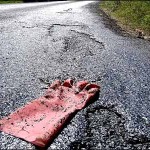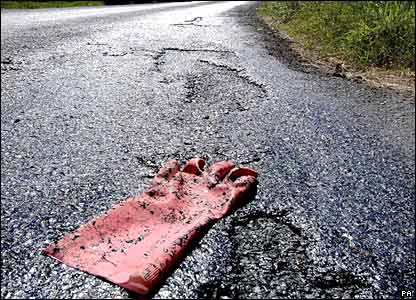 Like any other road on any other highway, the Venezuelan highway system is plagued with potholes, animal crossings, and the proverbial dead man’s turn. However something else lurks in the Venezuelan roads and it has taken the lives of 1,800 motorists within the past five years. What this something is remains a mystery to the many locals it has affected as well as those state officials that have tried to identify the mysterious killer known as La Mancha Negra.
Like any other road on any other highway, the Venezuelan highway system is plagued with potholes, animal crossings, and the proverbial dead man’s turn. However something else lurks in the Venezuelan roads and it has taken the lives of 1,800 motorists within the past five years. What this something is remains a mystery to the many locals it has affected as well as those state officials that have tried to identify the mysterious killer known as La Mancha Negra.
La Mancha Negra (The Black Stain) is a mysterious goo-like substance that has been reported all throughout the Venezuelan highway system. Seeping up through the hot asphalt in random places and at times covering an area as large as eight miles, La Mancha Negra is more gum-like in consistency than oil and is almost impossible to get rid of.
Initially, those who knew about this strange blob thought it was excess oil from the hot asphalt. Possible the result of shoddy road work, but when Government officials looked into the matter they were left scratching their heads as to what this substance is. Cleaning the goo is futile, since it always comes back the following day.
It’s only a matter of time before someone finds the culprit responsible for all these unfortunate deaths, but for now….the death toll keeps rising as investigations are launched to find out what exactly is La Mancha Negra.
Source: Seattle Times
CARACAS, Venezuela – The driving is easy. The road is smooth. Suddenly the car spins and swirls out of control as it skates along a layer of goo that mysteriously covers highways here.
Venezuelans call the goo La Mancha Negra – the black stain – but it’s really more like a blob, a thick black sludge with the consistency of chewing gum. No one knows what it is. No one knows where it comes from. No one knows how to get rid of it.
Some say it’s oil oozing from poorly made asphalt. Others say it’s oil falling from overworked car engines. It could be burned rubber from frayed tires. Some people think it’s all of the above.
Motorists are petrified of the blob. Government officials have spent millions of dollars trying to find out what it is, using local experts and others from the U.S., Canada and Europe.
They’ve formed a national commission to study the blob, and even a federal judge is investigating.
“We don’t know what it is. We clean it away and it comes back the next day. It’s frightening,” said Arturo Carvajal, an engineer and vice president of a company trying to remove the goo from a major Caracas highway.
PRESSURIZED WATER
Carvajal’s company and others have tried washing the blob away with pressurized water and detergent. They’ve tried blowing it away with pressurized air.
They’ve tried drying it up with piles of pulverized limestone. And they’ve scraped it away by repeatedly replacing the top layer of
asphalt on some blob-infested highways.
At various times, the government has declared victory, only to have La Mancha Negra return bigger and worse than ever. And it’s reproducing, somehow moving from one highway to the next throughout Venezuela.
The blob also is a killer: More than 1,800 motorists have died in the past five years on one eight-mile stretch of blob-covered highway between Caracas and the city’s international airport.
“Driving with La Mancha Negra is like driving in a grand prix. You’ve got to be careful, or you’ll die,” said Antonio Perez, a taxi driver who frequently deals with the blob on the airport highway.
FIVE-YEAR MYSTERY
It was on this road five years ago that La Mancha Negra first appeared. The government was patching the 30-year-old concrete highway with asphalt when the first shiny blotches appeared. Few Venezuelans took notice. The blob was in its infancy.
At first the blob covered 50 yards. Then 100 yards. Then a mile. And now eight miles, though the blob contracts and expands depending on the weather. Rain and heat make the substance grow; cold and dryness make it shrink. The blob also seems to like it best in tunnels, and it prefers the uphill lanes on grades rather than level roads.
In a nation where corruption is endemic, many Venezuelans think someone made big money – and unexpectedly created the blob – by laying cheap asphalt that bleeds oil when the temperature rises. Others think someone is making big money by repeatedly botching the repair job.
That’s where the judge comes in. He has been investigating charges of corruption since last year, but no one has been fingered. Not the Ministry of Transportation and Communications, which is responsible for taking care of the nation’s highways. Not the Venezuelan national oil company, which provided the asphalt.
“There could be corruption, but who knows for sure? Everybody is giving a different explanation. It’s a total mystery,” said Ruth Capriles, Venezuela’s foremost whistle-blower and author of the two-volume “Corruption Dictionary,” a compendium of the nation’s worst cases of graft.
Capriles, like most Venezuelans, has pet theories about La Mancha Negra. She thinks political opponents of President Carlos Andres Perez may be dumping oil on the roads to make his government look bad. And then there is the theory that raw sewage from slums somehow is flowing under the roads and triggering a chemical reaction in the asphalt.
AS SLICK AS ICE
Whatever the source of La Mancha Negra, it makes driving hell. Motorists say roads become as slick as ice when the blob is at full strength. Drivers slow to a snail’s pace, and they don’t dare hit the brakes or turn quickly for fear of doing a 360 and ending up in the trees.
On the airport road, where multiple-car pile-ups are common, huge red signs warn motorists to slow down and drive with caution. Four nights a week, the uphill side of the road is closed while 50 workers wash, blow, scrape and pulverize the blob.
Workers say they finally had the monster on the ropes in April, when they covered it with crushed limestone. It shriveled and shrunk and all but disappeared. But when motorists complained that dust made it difficult to breathe, the blob was given a reprieve.
Now, workers are out of answers. That makes Venezuelans tremble.
“They can offer me double the fare, but if La Mancha Negra is bad I won’t drive. It’s not worth dying for,” said Orlando Acevedo, another taxi driver.





